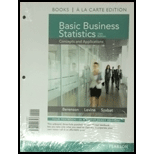
Concept explainers
a.
Find the day in which the proportion of non-conformances is the largest and smallest.
a.
Answer to Problem 1PS
The proportion of non-conformances is the largest for day 5 and the smallest for day 3.
Explanation of Solution
The proportion of nonconformers is computed using the formula given below:
Where,
Use Minitab to calculate the proportion for each subgroup.
Software Procedure:
Step by step procedure to find the proportion for each subgroup using Minitab is as follows:
Enter the given data in the Minitab workbook.
Select Calc Calculator.
In the calculator dialog box, in the Store result in variable box type proportion.
In the expression box enter the formula: ‘Nonconformers’ / (’Sample Size’).
Click on OK.
In the Minitab output: a column named proportion is computed.
From the output, the largest proportion of the non-conformances is 0.22 and it is on day 5 whereas, the smallest proportion non-conformances is 0.10 and it is on day 3.
b.
Find the values of LCL and UCL.
b.
Answer to Problem 1PS
The UCL is 0.2545 and the LCL is 0.0415.
Explanation of Solution
The UCL is computed using the formula given below:
And, LCL is computed using formula given below:
Where,
Use Minitab to calculate the proportion for each subgroup.
Software Procedure:
Step by step procedure to find the proportion of nonconforming items in all the subgroups combined using Minitab is as follows:
Select CalcColumn Statistics.
In the Column Statistics dialog box, check the mean box.
Select proportion in the Input variable box.
Click on OK.
Similarly, the mean subgroup size is computed by selecting Sample Size in the Input variable box in step 4 mentioned above.
Mean of proportion is 0.148, that is,
And, the mean subgroup size is 100, that is,
The UCL is computed using the formula given below:
And, the LCL is computed using the formula given below:
Therefore, the UCL is 0.2545 and the LCL is 0.0415.
c.
Find if any special cause of variation exists or not.
c.
Answer to Problem 1PS
There does not exist a special cause of variation.
Explanation of Solution
Special cause of variation exists if the proportion of nonconforming items do not lie within the control limits for the proportion of nonconforming.
The control limits for the proportion of nonconforming are
Since all the proportion of nonconformances lie within the control limit, there does not exist any special cause of variation.
Want to see more full solutions like this?
Chapter 19 Solutions
Basic Business Statistics, Student Value Edition (13th Edition)
 Glencoe Algebra 1, Student Edition, 9780079039897...AlgebraISBN:9780079039897Author:CarterPublisher:McGraw Hill
Glencoe Algebra 1, Student Edition, 9780079039897...AlgebraISBN:9780079039897Author:CarterPublisher:McGraw Hill
